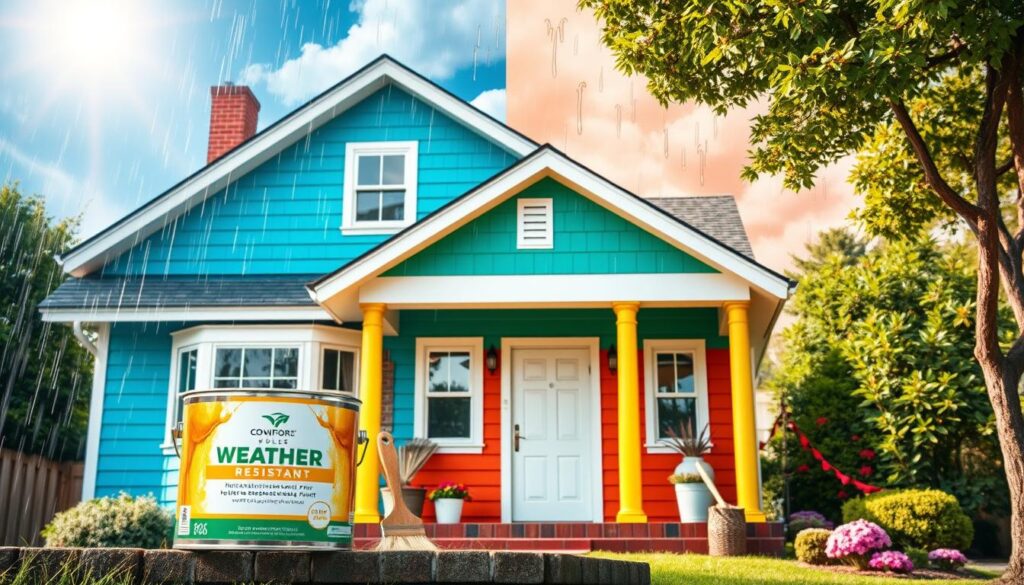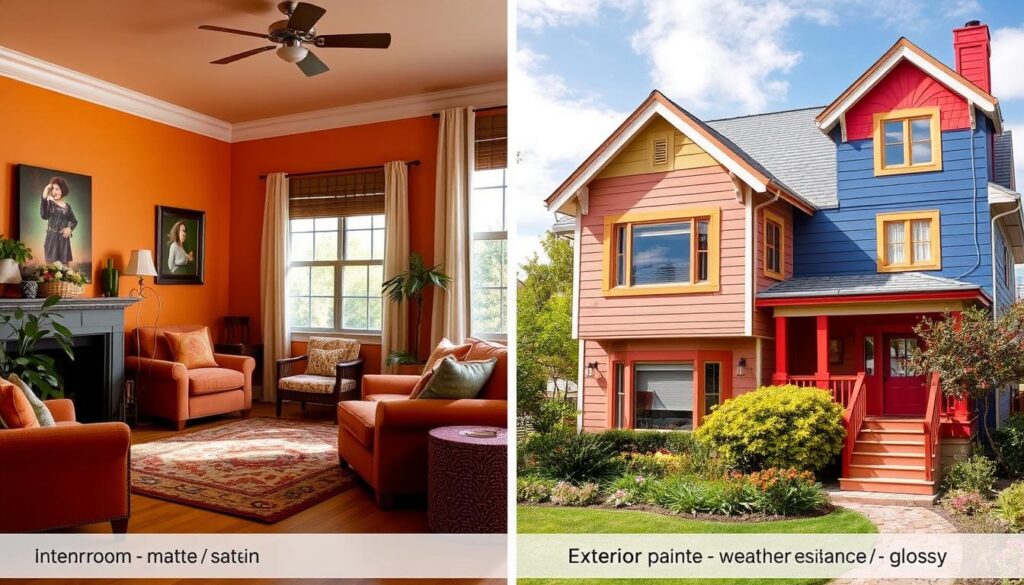Choosing between interior and exterior paint is key for your home’s look and life. Both types protect and beautify surfaces, but they’re made differently. They need different ways to apply and last longer.
Knowing the difference between interior and exterior paint is vital. It helps you pick the best paint for your project. Whether it’s for your living room or your home’s outside, the right paint makes a big difference.
In this guide, we’ll explore the science behind these paints. We’ll look at their special features and why choosing the right one is important for a lasting finish.
Understanding Paint Basics: The Foundation of Paint Types
To understand the difference between interior and exterior paints, we need to know the basics. Paint quality and performance depend on its chemical makeup. Knowing the role of key ingredients helps us see what makes each paint type special.
Chemical Composition and Base Ingredients
Every paint starts with base ingredients like resins, solvents, and additives. These work together to give the paint its texture, flow, and performance.
The Role of Binders and Pigments
Binders are the glue that holds the paint together. They make sure the paint sticks to the surface.
Pigments add color and make the paint look solid. How binders and pigments work together affects the paint’s look, durability, and how well it covers.
Paint Formulation Technologies
The paint world is always changing, thanks to new technologies. From water-based acrylics to oil-based enamels, each type has its own strengths and weaknesses. They’re made to meet the needs of different painting jobs.
Learning about paint composition helps us understand what makes each type special. This knowledge helps us make better choices for our painting projects.
| Ingredient | Function | Impact on Paint Performance |
|---|---|---|
| Resins | Provide adhesion and film formation | Affect durability, flexibility, and gloss level |
| Solvents | Facilitate application and drying | Influence viscosity, drying time, and odor |
| Additives | Enhance specific properties, such as mildew resistance or flow | Improve specialized performance characteristics |
| Binders | Bind the paint components together | Determine adhesion, durability, and flexibility |
| Pigments | Provide color and opacity | Affect coverage, hiding power, and UV resistance |
Interior vs. Exterior Paint: Key Differences Explained
Paint comes in two main types: interior and exterior. Each type is made for different places and needs. They have special features and how they work.
Interior paints are for inside use. They focus on being stain-resistant, easy to clean, and keeping colors bright. Exterior paints, on the other hand, protect against weather and UV rays. They also keep moisture and mold away.
| Property | Interior Paint | Exterior Paint |
|---|---|---|
| Composition | Acrylic, latex, or oil-based | Acrylic, latex, or oil-based with additional weatherproofing additives |
| Durability | Designed for indoor use, less resistant to weathering | Formulated to withstand outdoor exposure, temperature fluctuations, and UV radiation |
| VOC Levels | Lower VOC content for improved indoor air quality | Higher VOC levels to enhance weathering and mildew resistance |
| Sheen | Variety of sheens, from flat to high-gloss | Typically higher sheen for enhanced durability and washability |
Choosing between interior vs. exterior paint depends on your project’s needs. Knowing the differences helps pick the right paint characteristics. This is important for both indoor and outdoor projects.
The Science Behind Indoor Paint Formulations
Choosing the right paint for your home is all about understanding the science. These paints are made to handle indoor challenges. They keep your home looking great and the air clean.
VOC Levels and Indoor Air Quality
Volatile organic compounds (VOCs) are a big deal in paint. They can harm indoor air quality and health. Modern paints have low or no VOCs. This makes them safe for your health without losing quality.
Stain Resistance and Washability
Paints need to last through daily messes. Stain-resistant and washable paints make this easy. They keep walls looking new by fighting off stains and being easy to clean.
Color Retention in Indoor Settings
Good indoor paints keep colors bright and true. New technologies help colors stay vibrant, even with light. This means your colors will stay beautiful for years.
Knowing how paint is made helps you choose better. You get lasting quality, better indoor air quality, and the look you want in your home.
“Indoor paint formulations are a true testament to the power of modern science, balancing functionality, health, and visual appeal.”
Exterior Paint: Built to Battle the Elements
Exterior paint is all about durability, not just looks. It’s made to face the outdoors head-on. This weather-resistant paint keeps your home’s outside looking great for years.
It’s also packed with UV protection. The sun’s rays can fade paint fast. But, special pigments in outdoor paint block UV light. This keeps your home’s color bright and true.
Another key feature is being moisture-resistant. These paints keep water out, stopping mold and peeling. They also stretch and shrink with temperature changes, avoiding cracks.
- Engineered to withstand harsh weather conditions
- Provide superior UV protection to preserve color and finish
- Formulated to resist moisture, preventing mold, mildew, and peeling

Exterior weather-resistant paint uses the latest tech for lasting protection. It fights off sun, rain, and temperature swings. Your home’s outside stays looking top-notch, year after year.
Durability Factors: How Each Paint Type Performs
Choosing the right paint is key for your project. Whether it’s for inside or outside your home, paint’s durability matters. It affects how long your surfaces look good.
Impact of Weather and Temperature
Outdoor paints face tough weather like rain, wind, and temperature changes. Paint durability keeps surfaces strong and prevents early wear. Indoor paints deal with less harsh conditions but still face moisture and temperature shifts.
UV Resistance Properties
The sun’s UV protection is vital for outdoor paints. UV rays can fade, chalk, and damage paint. Good outdoor paints block and reflect UV light, keeping colors bright and surfaces intact.
Moisture and Mold Prevention
Both indoor and outdoor paints must fight mold and mildew. Mold prevention is crucial in damp or humid places. Choosing paints with strong moisture resistance helps protect your surfaces and keeps them looking great.
| Durability Factor | Interior Paint | Exterior Paint |
|---|---|---|
| Weather Resistance | Moderate | Excellent |
| UV Protection | Low | High |
| Mold Prevention | Good | Excellent |
“Choosing the right paint type for your project can make all the difference in the long-term performance and appearance of your surfaces.”
Cost Comparison and Value Analysis
Painting is more than just the initial cost. It’s about the long-term value and cost-effectiveness of interior and exterior paints. This is key for homeowners and contractors who want to save money. Let’s look at what affects paint prices and how to get cost-effective painting that lasts.
The price of paint changes based on quality, brand, and type. Premium interior paints might cost more at first. But, they last longer and need fewer touch-ups. On the other hand, cheaper exterior paints may need more frequent repainting, raising the total cost.
To save on cost-effective painting, try these tips:
- Choose high-quality paints for better coverage and longer life, even if they’re pricier.
- Make sure to prepare the surface well to make your paint job last longer.
- Look for discounts or contractor prices for big projects to cut down on paint prices.
- Remember to include labor costs and any needed repairs or touch-ups in your budget.
Understanding the long-term value of your paint choices helps you make smart decisions. It improves your space’s look and gives you a good return on investment. With smart cost-effective painting, your space will look great and be protected for years.

Application Techniques and Best Practices
Getting a professional paint job is more than picking the right paint. You need to know how to apply it and follow the best practices. This is true for both inside and outside painting jobs.
Surface Preparation Methods
Before you start painting, you must prepare the surface. This means cleaning, sanding, and priming. Doing this right ensures the paint sticks well.
- Thoroughly clean the surface to remove dirt, grease, and any existing paint or coating.
- Sand the area to create a smooth, even base for the new paint.
- Apply a suitable primer to further enhance paint adhesion and coverage.
Tool Selection and Usage
Choosing the right painting tools makes the job easier and looks better. Brushes, rollers, and sprayers each have their own uses. They work best for different surfaces and conditions.
| Tool | Best Uses |
|---|---|
| Paint Brushes | Cutting in edges, painting trim, and reaching tight spaces |
| Paint Rollers | Covering large, flat surfaces efficiently |
| Paint Sprayers | Achieving a smooth, even finish on exterior surfaces and projects with numerous nooks and crannies |
Optimal Weather Conditions
The weather can affect your painting project. Look out for temperature, humidity, and rain. These factors help the paint go on smoothly and last longer.
- Aim to paint in mild, dry weather, typically between 50°F and 90°F.
- Avoid painting in direct sunlight, as this can cause the paint to dry too quickly and lead to uneven application.
- Monitor humidity levels, as high humidity can interfere with proper paint drying and curing.
By using these techniques and following best practices, you can make your painting projects look professional. They will last a long time.
Common Mistakes When Using the Wrong Paint Type
Choosing the right paint is key to a successful project. Using the wrong paint can lead to big problems. For example, using interior paint outside can cause it to fade, peel, and even damage the structure.
On the other hand, exterior paint inside can lead to poor coverage and health risks. This is because it has high levels of volatile organic compounds (VOCs).
Another mistake is not preparing the surface properly. Not cleaning, sanding, or priming can cause the paint to not stick well. This results in a bad finish that doesn’t last.
Also, ignoring the weather conditions can ruin the paint job. It can cause blisters, cracks, or an uneven look.
To get a great paint job, research what your surface needs. Choose the right paint for your job. Avoiding these paint selection errors and following best painting mistakes practices will give you a lasting, professional finish. Proper paint usage is essential for a finish that lasts.
FAQ
What is the difference between interior and exterior paint?
Interior paints are made for walls and ceilings inside. Exterior paints handle the outdoors, like UV rays and moisture. They last longer because of this.
Why is it important to choose the right paint type for a project?
The right paint makes a project last longer and look better. The wrong paint can wear out fast, change color, or even harm your health.
What are the key ingredients in paint formulations?
Paints have base ingredients, binders, and pigments. The base makes the paint flow right. Binders stick it to surfaces. Pigments give color and cover.
How do interior and exterior paints differ in their chemical composition?
Interior paints have less VOCs and binders because they face less stress. Exterior paints are stronger against weather and UV rays.
What performance characteristics are important for interior paint?
Interior paint needs to be low in VOCs, stain-resistant, and easy to clean. It should also keep its color well. These traits keep air quality good and the paint looking new.
What features make exterior paint suitable for outdoor use?
Exterior paints resist UV rays, temperature changes, and moisture. They have additives for better weather and moisture resistance, and to stop mold and mildew.
How do the durability factors of interior and exterior paints compare?
Interior paints are not as durable as exterior paints. Exterior paints last longer because they face harsher conditions. They are made to handle weather and UV rays better.
What factors should be considered when comparing the costs of interior and exterior paints?
Look at the initial cost, long-term value, and cost-effectiveness. Exterior paints might cost more upfront but last longer, saving money in the long run.
What are the best practices for applying interior and exterior paints?
Proper preparation, the right tools, and good weather are key. Follow the manufacturer’s advice for the best results. This ensures a lasting finish.
What are the common mistakes when using the wrong paint type?
Wrong paint can cause wear, color changes, peeling, and health risks. Always choose the right paint for the job to avoid these problems.


